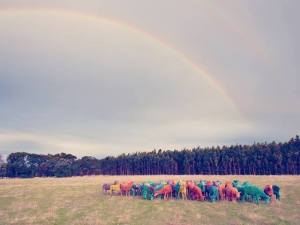Exponent II's Blog, page 137
July 8, 2021
Of Our Past and Other Hard Truths
“My name is Andrew Windyboy. I’m a Chippewa Cree. I did two boarding schools, one in Wahpeton Indian School in Wahpeton, North Dakota and the other one is Flandreau Indian School in Flandreau, South Dakota… They took me to the boarding school where I wasn’t allowed to talk my native tongue or practice my native ways. Numerous times they put on this big old white, big huge white cone. They put it on there, it said ‘dunce.’ I didn’t know what it meant. I didn’t know English. They put it on me, made me wear it all over. Kids laughed at me. (They) took me away from all of that and punished me for talking… It was my first language. I didn’t know any other language. And when I would talk, it came out, Cree would come out. Whenever I talked I would get hit. I got hit so much I lost my tongue, lost my native tongue…They beat me every day. Beat me badly.
“I hope someday somebody will hear me…”
Call it what it is: genocide. Does that feel too strong? Maybe we think that genocide belongs to other people, far away, over oceans and back through time. What if I told you the US and Canada had a goal to assimilate or exterminate all Indigenous people? Officer Richard H. Pratt, founder and superintendent of Carlisle Indian Industrial School, said, “A great general has said that the only good Indian is a dead one, and that high sanction of his destruction has been an enormous factor in promoting Indian massacres. In a sense, I agree with the sentiment, but only in this: that all the Indian there is in the race should be dead. Kill the Indian in him, and save the man.”
Assimilate. Or Exterminate.
And they did. Residential school workers in the US and Canada hid abuse and deaths, but Indigenous people knew. This isn’t trauma porn. But I will be using first-hand accounts, so this is a trigger warning for abuse, rape, death.
Darlene Whitehead said, “…it was the residential “schools” that constituted the death camps of the Canadian Holocaust, and within their walls nearly one-half of all aboriginal children sent there by law died, or disappeared, according to the government’s own statistics.”
A Canadian Truth and Reconciliation Commission (one of two) said that children were malnourished, beaten and abused as part of a system that it called “cultural genocide.” Eldon Yellowhorn (Piikani Nation) saw the architectural drawings for residential schools, saw space set aside for cemeteries. “They were planning for death.”
Genocide: the deliberate killing of a large group of people, especially of a particular ethnic group, with the aim of destroying the group. “Kill the Indian…” Assimilate. Or exterminate.
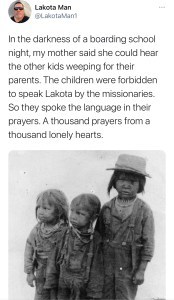
Does God hear the prayers of the little ones?
‘But it was so long ago!’ I hear some saying. Not that long ago. The first Residential school opened in 1860 on the Yakima reservation in Washington. In 1891, Congress enacted a compulsory attendance law, enabling government agents to forcibly remove children from their homes, often without saying goodbye to parents. When families refused to send their children, the government responded by arresting the parents and withholding rations and supplies. By 1926, more than 80% of all Indigenous school-age children had been forced to attend boarding schools. In 1973 alone, an estimated 60,000 Indigenous children were enrolled in residential schools run by the federal government or religious organizations, including The Church of Jesus Christ of Latter-day Saints. The last government-controlled residential school closed in 1996. The stories I share are from people now living. Surely people who reenact handcart pulls from the 1800s would hold their government responsible for killing children in our lifetime. If it had been your child, how far would you push for answers and amends?
Death was all around the children. Tim Gaigo (Nanwica Kciji; Oglala Lakota) tweeted, “When I was a student (prisoner) at the Holy Rosary Indian Mission one of my friends “Bozo” Richards died from an ear infection. Roch Red Elk and I were assigned by Father Edwards to dig his grave at the old Mission cemetery. We had a pick and a shovel. It was my turn to be in the grave with the pick and we were about 5 feet down when my pick hit something and I pulled it up over my head and there was a tiny skull stuck on it. We had dug into an unmarked grave where a small child had been buried.”
Ruth Roulette (Long Plain First Nation) arrived at a boarding school when she was 6. On her first day, a nun silently handed her a pencil and paper and, when she didn’t respond quickly enough, punched her in the face. “There was blood everywhere. I didn’t know what I did wrong. I just cried and cried, and then I had to clean up all the blood.”
Tim Gaigo says, “I was beaten with a leather strap from my ankles up to my back (for attempting to run away). I can remember how the ex-sergeant (turned priest), would still wear his army boots under his robe…he almost beat me to death. A few years later…my little sister was raped.”
Saa Hiil Thut, survivor of Kamloops Residential school, remembers teenage boys too afraid to make a sound. “The violence there was paramilitary, and it was controlled with great strictness. Punishment was the way they kept silence and kept order.” He says, “It is that place where I started to hear the word stupid Indian, drunken Indian, lazy Indian…and I know that part of it was…the government of the day wanted to dehumanize us and to assimilate us and to rub us out.”
Food was scarce or inedible. Children would eat and throw up, then be forced to eat their own vomit. Hunger, hand-in-hand with humiliation, echoed through the hallways. The pain was the point. The trauma was the point. Genocide.
Daniel Heath Justice (Cherokee Nation) tweeted, “The deaths of stolen children mattered long before the numbers started adding up in such horrific amounts. Remember this. Greater numbers don’t change the fundamental tragedy that none of these children should have died away from loved ones. None should have been abused. NONE.” But the numbers are huge.
Ground-penetrating radar shows 182 shallow, unmarked graves near the St. Eugene’s Mission School, where children from the Ktunaxa and ?aqam nations were forced to attend.
Underneath what is now a city park on Brandon Residential School grounds, at least 100 graves lie marked only with a single plaque: Indian children burial ground. They had names. They had hopes and fears. They had food they liked and food they hated. They had parents and grandparents who loved them, mourned them, hungered for their return.
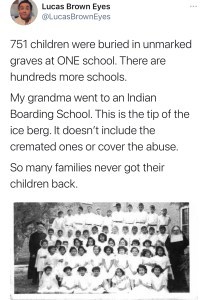
What would you do if it were your child?
Jasper Joseph cried as he remembered his cousins, killed by lethal injection at Nanaimo Indian Hospital in 1944. While Diné code talkers helped the US free people from gas chambers, our governments were killing their children in residential schools. The languages we forbade were the very ones that saved our troops.
The damage done is generational, community-wide, and, I believe, infects us all. Dr. Maria Yellow Horse Brave Heart describes historical trauma as “…the cumulative emotional and psychological wounding over one’s lifetime and from generation to generation following loss of lives, land and vital aspects of culture.”
In addition to the emotional damage, Indigenous nations faced other losses: the loss of future elders and leaders, the loss of language and stories, the loss of memories that could have been made. Children, even those who survived, lost their communities and often faced lifetimes of health problems related to their experiences. All of this faces us as we try to repair the damage.
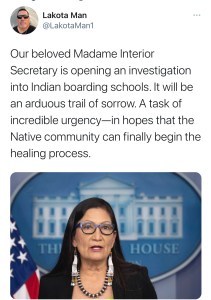
The only way to heal is to go through the painful process of understanding how much damage has been done.
While Canada has been wrestling with it’s past, the United States is just starting to investigate on a large scale. Interior Secretary Deb Haaland (Laguna Pueblo) directed the department to compile a report of available historical records related to the US Federal residential schools, including known cemeteries or potential grave sites. She said, “I am a product of these horrific assimilation policies. My maternal grandparents were stolen from their families when they were only eight years old and were forced to live away from their parents, culture and communities until they were 13. Many children like them never made it back home.
As members of the LDS church, we have our own past to reckon with. Even after the residential school in Brigham City closed, the LDS church ran a “foster care” program until 2000, where baptized Indigenous children were placed in white LDS foster homes, usually with parents who had no qualifications other than being recommended by their bishop. According to a guide given to children, they were to “try to learn the accepted ways of behavior in the society in which you live. Be anxious to accept those ways of the church which will help you fit into the modern society of today.” They were not to speak their native language if anyone in the room was unable to understand them. And when they returned home in the summer, they were not allowed to participate in their native cultural or religious ceremonies. The purpose, like that of residential schools, was full assimilation. President Kimball cheered, “The day of the Lamanites is nigh. For years they have been growing delightsome, and they are now becoming white and delightsome, as they were promised.”
Bringing “Lamanites” to Christ begins with the assumption that the people living in the Americas pre-Columbus were somehow fallen, deficit, and in need of salvation. We’re still coming to terms with the cost of our hubris. In 1977, the US government investigated accusations that the LDS church was using its vast influence to pressure children, largely Navajo, to be baptized in order to enter the program. To date, more than a dozen plaintiffs have filed lawsuits against the LDS church, alleging physical and sexual abuse.
Bízhínłth baá (Navajo) filed a suit stating that her foster father raped her 3-4 times a week when she was 12. She reached out for help to a local leader of the Relief Society but says she was scolded, slapped, and told to be quiet.
LB filed a lawsuit after participating in the program in 5th grade. He was sexually molested by a bishop living across the street from the foster family. When he told his foster mother about the abuse, she accused him of lying, grounded him, and sent him to bed without dinner. After he reported it to a caseworker, his foster father spanked him. The abuse continued until he succeeded in getting himself kicked out of the program. We will tolerate abuse, it seems, but not petty theft.
I would like to think that of the 50,000 students who participated in the LDS program, these reports represent anomalies. But I’m not hopeful. Knowing how frequently Indigenous children were abused in other programs, and seeing our church’s history of shielding abusive leaders, I believe there are more stories out there.
How do we move forward?
First, we need to recognize that, although residential schools have closed, the attempted genocide of Indigenous Peoples is ongoing. Currently, the US and Canada are guilty of failing to adequately equip reservations, enacting paternalistic laws, obstructing Indigenous sovereignty, and failing to investigate murdered and missing Indigenous women. We can push for a change in those policies, encouraging our governments to honor the treaties we’ve signed, and show our support for Indigenous sovereignty.
Second, we can push for official apologies from governments and religious leaders. In 2008, the Canadian government formally apologized for residential boarding schools. PM Trudeau urged the Catholic church to do the same. It’s time for the US government, and the LDS religion, to do likewise. Michael Greyeyes (Nêhiyaw/Muskeg Lake Cree Nation) said, “This refusal (to issue a Papal apology) only cements that the mission was never about saving our souls. It was purely about subjugation and the obliteration of our presence on the land.” I haven’t even touched on the treatment of aborignal people in Australia and New Zealand, or the effects of British rule throughout Asia. If those are your nations, I would love to hear about your efforts to encourage accountability.
Third, we can advocate for reparations. Money can’t bring the children back, and it won’t ease the pain, but it can provide a path forward. After centuries of genocide, #landback is the first step in healing.
Fourth, we can do our own shadow work. Self reflection, and looking at the ways we, too, have biases and commit harm, can help us be the type of people I believe Christ asks us to be, “For inasmuch as you have done it unto the least of these, ye have done it unto me.”
While the residential schools carry with them a legacy of ongoing community trauma, they don’t mark the end of Indigenous people, who continue to thrive. As I write this, summer ceremonies are being held across the continent. Healing circles allow survivors to share their stories and mourn the loss of their childhoods. Elders pass on stories full of love and wisdom. Dorothy Visser, boarding school survivor, teaches Cree and urges community members to learn the word ‘nehiyaweh’win’ which means “retaining our heritage.”
Cornel Pewewardy (Comanche) wrote, “Whether we do this standing in front of hundreds of people or standing in the presence of two or three, we must walk in the way of an Indigenous paradigm with dignity, measured movement, and courage, lest we be found guilty in the presence of our ancestors of promoting the history and causes of our oppression.” We, too, need to walk with dignity and courage lest we be found guilty of causing oppression. Recognizing past mistakes, supporting current efforts at truth and reconciliation, and celebrating the beautiful, complex, varied ways Indigenous people continue to show up, reach out, and lift up will help us bring that peace promised to those who seek it.
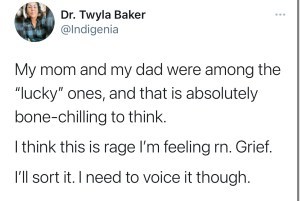
Let’s hold our siblings in love as they voice rage, pain, and grief. And then let’s fight to make the world more just.
July 6, 2021
Winter 2022 Annual Writing Contest – Proverbs & Idioms

Image by Amador Loureiro @unsplash
The family that prays together, stays together… Good things come to those who wait… Be in the world, but not of the world… Take this with a grain of salt… You can’t have your cake and eat it too… It was a tender mercy.
No matter where and how we grew up, we are surrounded by idioms, figures of speech, and proverbs—especially within the Church. They are saturated with history, culture, and meaning, often said but not as often pondered or interrogated. What happens if we take a closer look?
Brainstorm a list of these phrases that are familiar to you. When has one of these common sayings been challenged, complicated, or appeared more true than you ever imagined? When has it proved ironic? Funny? Flawed? What happens if people take it literally? Seriously? When has it haunted you or maybe even saved you or a fictional character?
Show us how a figure of speech has played out in your life or for another character. We are seeking a balance of fiction and nonfiction through short story and personal essay submissions. Get creative! If your idiom or proverb does not appear explicitly in your piece, be sure to put it as an epigraph under your title. If the saying is from another language, you can include the original language along with a translation.
Submissions should be 700-2400 words and in Google Doc or Word form. They can be sent to exponentiieditor AT gmail DOT com. Authors should identify with the mission of Exponent II. The deadline for submissions is October 1, 2021.
The winner of the contest will receive a one-week’s stay at Anam Cara, a writer’s retreat in Ireland. Our sincere thanks go to Sue Booth-Forbes, former Exponent II Editor, for making this award available.
We so look forward to reading your submissions!
All Best,
Exponent Editors
July 5, 2021
Floral Handkerchiefs
I was a tomboy as a kid. If there was a tree, I climbed it. If there was a bug, I caught it. I kept snails as pets. I was practically allergic to pink, and I would only wear dresses under duress.
I still don’t like pink or dresses. Until recently when I found a little black dress at Goodwill for a price I couldn’t pass up, I didn’t even own a dress. I do own a few skirts, but I only wear them to church or when the temperature gets above 120 degrees. (Or occasionally on laundry day if nothing else is clean.)
I do, however, like saving money. If there’s a reusable option for a consumable product, I’m inclined to choose it if it’s roughly comparable to the disposable option. I’ve been a cloth napkin user since I moved out of my parents’ house in my early 20s. I don’t buy paper plates or cups, and I carry a set of silverware in my purse so that I don’t have to use plastic cutlery when I do takeout. But the one thing I couldn’t bring myself to do was use handkerchiefs. It felt unsanitary.
Last week, I decided to get over it. I had an old scarf that had developed two giant holes in the middle. I cut it up into squares and became the owner of 38 raggedy-edged recycled handkerchiefs. The scarf was dark blue, light blue, dark purple, and black. Because of the design, each handkerchief was unique. I liked the bold colors – no frilly grandma lace for me.
It’s the height of allergy season, so I had my chance to test out my reclaimed hankies. They were more comfortable on my nose than tissues, and they held up to cat vomit as well. I was sold. However, it turns out that 38 isn’t quite enough to get through a week. That surprised me. I figured I would need no more than a dozen at most.
I took to the internet to get some more. To my surprise, handkerchiefs are heavily gendered when shopping. Apparently it matters whether people deposit mucus onto frilly pink and white lace or bold blue and green plaid. Men’s handkerchiefs are also twice as large, to handle man-snot, I suppose. And in a reversal of the typical pink tax, women’s handkerchiefs are considerably cheaper.
After going back and forth and wondering if I should just get men’s handkerchiefs and cut them in half to make them a less ridiculous size, or wondering if I could buy a nice neutral fabric and pay a friend to make some for me, I finally decided that blowing my nose on floral fabric won’t do me any harm. So I bought a 60 pack of lady-hankies.
They arrived yesterday. While I’m not thrilled about the designs, they’re not as bad as they looked online. They’re white cotton squares with some flowers on the fabric. Perfectly functional, and there’s no reason I need to enjoy the aesthetics of an item in order for it to be useful.
 Mason jar with handkerchiefs folded in such a way that they can be dispensed from the lid
Mason jar with handkerchiefs folded in such a way that they can be dispensed from the lidI have a mason jar on my living room end table with the handkerchiefs folded in such a way that they pop out of the top like paper tissues. And I keep a few in my purse. I’m kind of looking forward to the day I need to wipe my nose at the archery range. Shoot a bullseye and then pull out some frilly cloth to take care of the allergies. Keep everyone’s heads spinning from the juxtaposition.
I tried to come up with a spiritual point for this post, and there’s probably one lurking in the background somewhere, but I can’t think of it at the moment. But now that I have 98 handkerchiefs (38 reclaimed ones from the old scarf and 60 from the multi-pack I bought), if we ever have another apocalyptic paper shortage like 2020, at least I’ll have something to blow my nose on. So I guess this is a blog post about food storage!
July 4, 2021
It’s Time for Girls To Help With the Sacrament
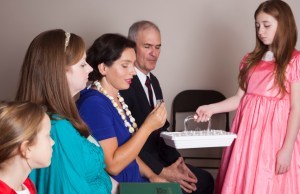
Photo credit: OrdainWomen.org
Last Sunday before church, my 14-year-old son was complaining about needing to arrive at church 25 minutes early to prepare for the sacrament (alone). Apparently, he is often the only Teacher who arrives early, and he’s tired of being the one to shoulder the majority of this task.
This sounded like a valid complaint to me. I asked my husband why this was happening, and he said a couple other Teachers may arrive 5 minutes before the start of the meeting, but they just don’t often get there early enough to help much.
I said, “How about getting the young women to help? I imagine a couple of them could get there early and help prepare things?” My husband told me that the Church Handbook of Instructions (see section 18.9.2) clearly states that priesthood holders need to be the ones who both pass and prepare the sacrament.
I knew that was the case, but hearing him say it still filled me with annoyance. This policy, which keeps females away from preparing or passing the sacrament, is not scriptural. Sam Brunson covers this issue well in his great posts on this subject here and here.
There’s even historical precedent for girls and women preparing the sacrament. Brunson touches on this as well in his first post, but I thought I’d highlight a couple of other anecdotes from historical sources that give us insight into how women used to participate in the administration of this ordinance.
From William Hartley’s “From Men to Boys: LDS Aaronic Priesthood Offices, 1829-1996” in My Fellow Servants: Essays on the History of the Priesthood:
“Annette Steeneck Huntington recalled that during the 1930s in Emigration Stake, the ‘young girls in MIA … filled the water cups in the kitchen and placed the bread on the trays. We then prepared the Sacrament table with the cloth and trays on it. It was a wonderful privilege I shall always remember.” P. 70
“Women and custodians usually prepared the sacrament table, so it did not appear on a list of priesthood duties until 1933. … Women also baked the sacrament bread in many wards. Kate Coreless of Salt Lake City’s Fourth Ward took care of the sacrament table for a quarter century after 1906. She crocheted the cloth, polished the silver trays, baked and sliced the bread, and set the sacrament table.” P. 70
Clearly, as many have pointed out before, this tradition of having boys prepare and pass the sacrament is simply that – tradition. It’s not doctrinal. It’s not scriptural. And there’s even historical precedent for females to be involved if you go back a few generations. There’s simply no reason for girls to not help with this task. Very small inroads appear to be made on this front as some wards are having girls bring trays to nursing mothers in mothers’ rooms. Recently, I heard rumors that certain wards in the U.S. were experimenting with having women serve as clerks. (This has been happening for some time in Hong Kong, according to Stacilee Ford’s excellent article in Decolonizing Mormonism, “Sister Acts: Relief Society and Flexible Citizenship in Hong Kong.”) I’m glad to see that there may be some movement afoot to examine these gender exclusions and think seriously about the ways our tradition needlessly shuts out women from participating in certain ways.
But I’m not going to even try to justify these arbitrary exclusions to my annoyed son, who would appreciate some (male or female) help on Sunday mornings. I certainly won’t be justifying it to my 12-year old daughter. It’s time to rethink these policies. Young people are increasingly likely to see these inequities. It’s time to make these easy changes – and then get to the real business of tackling the harder ones.
June 30, 2021
Announcement: Exponent in Need of Fundraising Coordinator
Exponent II is searching for a Fundraising Coordinator, to increase the financial sustainability of the organization. Because this is a new role, Exponent II is open to collaboration on what this role may look like, and is willing to tailor it to the right candidate. The Fundraising Coordinator would support all pillars of Exponent II—the magazine, blog, and retreat. The primary responsibility would be to raise funds through approaches that suit the individual’s strengths and interests — e.g., applying for grants, running online campaigns. See full job description here. If interested, please send a cover letter and resume to board@exponentii.org by August 15, 2021.
June 28, 2021
Embrace Queerness – A Review of “Queer Mormon Theology – An Introduction”, by Blaire Ostler
A few years ago, I was talking with a friend about some of the strange and unique aspects of Mormon life and belief. He shook his head at one point in the conversation and said, “Mormons are weird.” Then he seemed worried that I might be offended at what he said. But I smirked, and said, “Absolutely! If you look up the word weird in the dictionary, the first example is Mormonism. I choose to embrace the weirdness.”
I think I always have. As I learned of my Mormon heritage, reaching back generations, I relished learning of the struggles along with the strengths, and especially the thoughts and ideas that were unlike anything I heard from other families. I liked hearing about teachings and questions and revelations that spoke of a God who was expansive, co-existing with us, and a belief that was encompassing of all things good and inspiring, from any source. Often, it is the unique and weird aspects of Mormonism that keep me connected to the church, even when leaders or fellow members display rhetoric and actions that are painful, marginalizing or destructive. Those actions are common to any organization or community which involves humans, and I learned I would encounter those anywhere. I felt drawn to what seemed unusual about my religious tradition, even and especially with the usual human elements.
I liked being a part of a peculiar people.
I mourn when there is any attempt by members to “normalize” the restoration experience or message. The world is full of pressure or opportunity to conform, blend in, or encourage acceptance through sameness and agreement. I don’t find that inspiring or inviting toward God or godhood. We have an entire pre-existence story that explains why. There we all were, intelligences which had existed as long as the Gods. But They had found ways to seek wisdom and grow in knowledge, creating new worlds as they sought to grow in complex experience and greater wisdom. They invited us to follow them, and become new beings, reborn in the journey toward divine existence. But there was opposition in this journey, pleasure along with pain, destruction along with creation. It could only work if those who stepped forward into the journey chose it with full understanding of the strange nature of it – the very opposition and complexity of the journey is what creates the process of godhood. If there were a predictable, guaranteed pattern for everyone to follow, where all was controlled so everyone would behave the right way and do the right things and be acceptable no matter what, there would be no inspiration, no progression, no practice that would transform us. Our story tells us that it was still difficult for us to choose freely. As we are all a part of each other, at least one third of our selves wondered if it might not be better to surrender any strange, peculiar, unpredictable, uncertain part of our journey. At least a third of our selves were drawn to safe, guaranteed sameness. Our pre-existence story tells us that God inspired and invited us to embrace an unpredictable, peculiar journey toward glorious wisdom and godhood.
I love how weird that is. And that is just one part of what I embrace in Mormon weirdness.

“Queer Mormon Theology – An Introduction” by Blaire Ostler. Cover Design by Christian Harrison.
Now, with the release of Blaire Ostler’s new book, “Queer Mormon Theology – An Introduction”, I have an eloquent published reference that includes so many aspects of what I love about Mormon belief. I also have an additional descriptive word. And the word is queer.
If you don’t need any more justification than that, then please just go and get this book and read it. Mark it up, turn down the page corners, put tabs in it so you can refer to it for talks, or lessons, or discussions, or meditation, or prayer, or those moments when you wonder why it is that you keep resisting some kind of conformity in any community, and that resistance seems to be connected with something that is deep in you, a part of you that connects to a divine journey that is uniquely, weirdly, queerly yours. I ask you to consider that the resistance to conform for the sake of conformity, the inspiring pull to be uniquely you even in a journey that is shared in part with countless others, is very Mormon.
I appreciate the way a book about queer theology, written by a queer woman can be such a valuable gift and resource for everyone and anyone seeking value in Mormon teaching and experience. I am a cis-het woman, who seeks understanding of the experiences and perspectives of my queer siblings in my efforts to be an ally and advocate. This book shares Ostler’s insights from her perspectives as a queer Mormon, and yet I felt I was reading about my own thoughts, as well. The use of the word “queer” in this book can apply to more than those who identify as LGBTQ+. It also applies to the peculiar nature of Mormon theology, and embraces it as such. In this broader sense, to be Mormon is to be queer. I celebrate a book that informs us about this.
And I am grateful for any new book that references Joseph Smith’s King Follett Discourse early and often. I began learning of this rich speech over 50 years ago, when I was still in primary. It helped shape my questions and ideas about being from that time on.
Ostler has written a concise and interesting volume which organizes her main areas of theology into chapters concerning God, Christ, The Family, Sexuality and Creation, Polygamy, and Policy. And she begins it all with a chapter about theology itself, to clarify her approach. Within the chapters, there are sections that examine aspects of the chapter subject. In the God chapter, section titles such as “God is Singular and Plural”, “God is Intelligence”, “God is Love”, “God is Dynamic”, invite the reader to consider reference from restoration scripture and thought that explores the theology expressed, as well as how it is queer, and how it can be inspiring for all.
That is one of things I appreciate about this book. Ostler is presenting a clear perspective and interpretation, sharing it with a variety of resources, reference, reasoning and personal experience. She is not arguing, or trying to convince anyone to agree or disagree. I felt she was offering a way of seeing, and the possibility of embracing the queerness of Mormon Theology.
I could elaborate on the many details I appreciated seeing in print, but I think you will find more value in reading it and discovering what is inspiring for you.
I will include a quote from a section in the chapter Concerning Christ. This is one of the most concise expressions of how the queer experience is very much a part of what Christ reveals in the Atonement – as experienced in Gethsemane, and in every moment of one-ness with each of us since then.
“In Gethsemane, Jesus experienced the pains of a person dying of cancer. He experienced what it is like to be a queer kid who is constantly bullied. He experienced the birthing pains of every mother who ever lived or would live. He experienced the embarrassment of a gay boy having an erection at the sight of his school crush in the locker room. He experienced conversion therapy. He experienced rejection. He experienced the brutal physical and psychological attacks that trans women endure. He experienced the acid poured on a woman’s face for her defiance to the patriarchs. He experienced the fear, grief, and sorrow of every parent who has buried their child. He experienced sex slavery. He experienced his first period. He experienced menstruation, not simply from a vagina but from every pore of his body. He experienced rape. He experienced catcalls. He experienced hunger. He experienced disease. He experienced an ectopic pregnancy. He experienced an abortion. He experienced a miscarriage and stillbirth. He experienced the Holocaust. He experienced war – both the killing and being killed. He experienced internment camps. He experienced depression, anxiety, and suicide. He experienced sleeping on the street with the homeless. He experienced the slave master’s whip on his back and the noose around his neck. He knew the fear of every black mother who kissed her son before he left the house, praying he would return home safely. He experienced the effects of unrighteous dominion, corrupt politicians, and all manner of injustice. He experienced the migrant mother with no food or diapers for her baby as she desperately walked north in search of a better life. He experienced having his child taken away from him at the border due to “legal complications.” He experienced it all – every death, every cut, every tear, every pain, every sorrow, every bit of suffering imaginable and beyond imagination. He experienced an onslaught of suffering, which was so great that it took a god to bear it. He experienced death and came through the other side to show us the way.” – Queer Mormon Theology pp. 38-39, by Blaire Ostler.
This is a moving account of the theology of At-one-ment, a most peculiar way of seeing that this deeply mystical connection is not about a demand for justice, or payment of debt. It is about being one with each and every being, in each and every moment of life – and the oneness is taken on because of incomprehensible love. This love is the power to transform us, that we may overcome all, even death. As Christ did.
This is not an easy, conforming way of seeing God. It is queer. It is inspiring.
It is in a book well worth reading.
June 27, 2021
Sacred Music Sunday: Abide with Me
This past week was the solstice – summer for the northern hemisphere and winter for the southern. I live in the middle of a hot desert, so summer makes me cranky. There’s an oppressive heat that drives everyone inside for all but the most essential errands. I’m crabby and prone to starting arguments, and it gets light so early in the morning that I can’t seem to get enough sleep. In short, it’s miserable. I imagine the people weathering the depth of winter have comparable though different complaints – the looming darkness, the ever-present chill.

The solstice reminds us that the depths of our extreme seasons have an end. I’m now moving toward cooler, more bearable temperatures. Those south of the equator are moving toward longer, warmer days.
A hymn that captures this feeling for me is Abide with Me. It’s a plea for God to be with us through our good times and our bad times, our cloudy days and our sunny days. And the book of Revelation promises us that for the righteous, this prayer will be answered: “They shall hunger no more, neither thirst any more; neither shall the sun light on them, nor any heat. For the Lamb which is in the midst of the throne shall feed them, and shall lead them unto living fountains of waters: and God shall wipe away all tears from their eyes.” Revelation 7:16-17
June 25, 2021
Artist Spotlight – Tiare Terrill on her cover for The Book of Mormon for the Least of These
Spotlight is a new feature on the Exponent II blog to shine light on individuals or projects in the world of Mormon Feminism outside of book reviews. This is part two of a spotlight of Dallas-based artist and mother of five, Tiare Terrill. You can read part one here. In part two, we discuss her cover for The Book of Mormon for the Least of These, Volume 1, by Fatimah Salleh and Margaret Olsen Hemming.
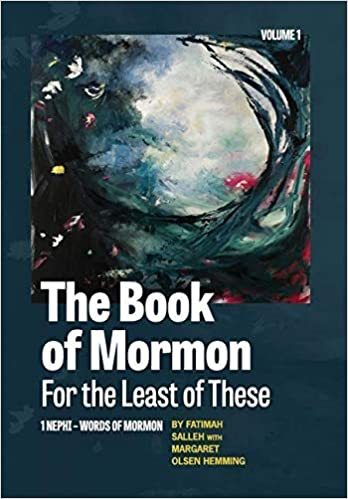
Q: How did you come to do the cover for The Book of Mormon for the Least of These?
A: Margaret Olsen Hemming [one of the co-authors of the book] reached out to me. It was one of the years that we were building our house, sending our daughter on a mission, and one of our boys was in his senior year. That year I passed on a lot of work. But Margaret contacted me and said that she found me online and that they really love how I play with dark and light and asked about using my painting.
Q: Of course your painting ended up on the cover, but was that an easy decision for you?
A: I wasn’t familiar with Margaret when she first approached me, and I was like, I have to tell you, I have a deep testimony of The Book of Mormon, and I have to feel good about this. I asked her to tell me about their project and the tone of the book. She said she would send me the talk that was sort of where her journey with this book began. She talked about the injustices and the racial undertones in The Book of Mormon, and as she has worked it out for herself, she has felt like the book is an opportunity to address those issues head on, instead of just brushing it under the rug or not discussing it or nor dealing with it. It was an opportunity to look at it for what it was and develop some compassion and empathy.
After I read her talk, and talked to [my husband] David about it, and he was supportive, I did a little bit of praying. I’m a very spirit-led person, and I’m that way with everything. Something just has to feel right. With homes we buy or other big decisions, I just need to feel like I’m on the right path and I’m doing the right thing. I felt like I could trust Margaret as soon as I read her point of view and what the book was about. I felt good about it and really honored that they were interested in me being part of the project. And it’s a great book. I loved it.
Q: Margaret told you she reached out because they were drawn to your play with dark and light. That seems to be a prominent theme in your work. Can you tell me about that?
A: So much of my life, I’ve experienced these moment of peace and happiness and joy, and usually that has come after some really hard things. So I really believe that as we evolve personally and as a people, that it is through these moments of darkness that I’ve grown the most. When I’ve gone through things that are really hard, like some of my experiences growing up, and like we all do in life, it’s when I come out on the other side that I can actually appreciate the light.
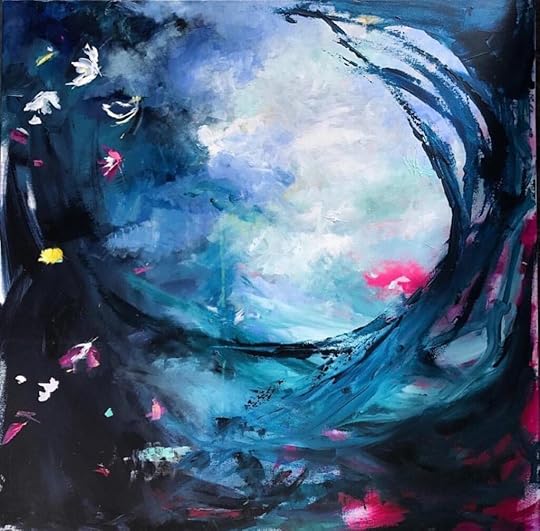 “Swept Up” by Tiare Terrill
“Swept Up” by Tiare TerrillQ: The painting on the cover of the book is called “Swept Up.” What inspired you to produce this painting?
A: Our political climate has become increasingly divisive and downright ugly. People were losing their sense of humanity and it was getting more and more difficult to feel hopeful amidst so much hate and vitriol. I found myself asking God how I was supposed to raise kind humans who care about others, let alone the planet, and their impact in this world that has become so cynical and dark. I went to my easel as I usually do when I need to work something out and “Swept Up” just came out of me. The answer to that mother’s prayer: You love them. . . HARD. You pour so much love into them so that they can pour that goodness and light into the world, and then you have faith knowing that God has a plan for each of us and it will all work out in the end. After all, we might act ridiculous at times but in the end, we’re more alike than different and most people are inherently good.
Q: That sounds like it was a very powerful experience. I appreciate you letting me take up so much of your time. Is there any last message you want to share?
A: A sister who spoke in our last stake conference said, “We might not be able to control the chaos in the world but we can contribute to the goodness in it.” I believe there is so much good in the world if we just look for it. I feel strongly that if we can pour love into this next generation, they will be equipped to spread that goodness and light into our communities across the globe. So we keep fighting the good fight and show up and love hard and walk the walk on that whole love-thy-neighbor thing. The world needs it. I need it. We all need it.

You can find Tiare on her website or follow her on Instagram @tiareterrillartstudio
June 23, 2021
Behold, Your Little Ones: A Woman’s Witness

Public domain photo from Flicker
I am the mother of young daughters. I do the majority of childcare and spend the most time with them. I witness their dreams, their struggles, their assumptions about how the world works. I witness what they believe they can and cannot do. I witness how they take in the church’s patriarchal structure, and how they desire to participate. My husband is a loving, involved father. He isn’t there see these desires to the same extent I am (and even if he was, it would be a different experience for him.) I thought about how rare it must be for a male church leader to see young girls grappling with the patriarchal nature of the church. My daughter’s innocent assertions challenge me. Their hopes need to be seen. Here is some of what I’ve witnessed:
I listened to a two-year-old daughter dream of things she wants to do when she is “older-nuff”: feed horsies hay, ride a tiny horsie, break the sacrament bread. She’s gotten to do all of those things now, but that last item only happened because of the pandemic (and because she didn’t ask permission from daddy). I don’t know if she will ever get to act out her desire to serve in that way in a regular church meeting.
A three-year-old daughter frequently asked me to baptize her when she was old enough. It was hard to tell her that only men like daddy had the priesthood authority to baptize her. She asked him for a little while. A few months later, she was back to asking me to do it. She couldn’t understand why I kept saying that I wasn’t able to. She even showed me how by pretending to baptize me. I wonder what I am teaching her by saying I’m not allowed to do something that she knows I am physically able to do. Things that are not allowed should be either dangerous or unethical, but I don’t understand how authorizing a woman to perform a baptism is either of those things.
A three-year-old daughter pulled pretend oil out of her pretend pocket and pretended to give me a blessing, just like she’d seen the ministering brothers do. She wanted me to play too: it was my turn to give her a blessing now. I was lead by a little child to realize that I had authority to learn to bless others through play and pretend. My impromptu, pretend blessing felt very real.
A four-year-old daughter notices gender imbalance in children’s books. She comments: “I think that’s the only she in this book.” My girls notice the imbalance in the scriptures and church curriculum too.
A four-year-old writes her own “scriptures” because she doesn’t have her own. I find her self-confidence inspiring. I hope she continues to write her own scriptures once she learns how to spell. I want to read them. Maybe I should try writing some myself. If women don’t write, women’s perspectives will be absent from the narrative, again.
A four-year-old declared: “I want to be a boy!” I simply asked: “Why?” Her response: “Because I want to do the sacrament.” A girl’s body is capable of doing all the tasks associated with this ordinance. It was women who came to the tomb to prepare Jesus’ body. I hope my daughter can be happy with the body she has. I do not wish for her to feel limited in what she can do with her hands and voice because of parts of her body that few people will see.
A five-year-old was watching the beginning of Women’s Conference with me while waiting for her turn in the bathtub. Seeing the choir of all women, she says, “There is only girls at girls conference and only men at the men’s conference, right?” I tell her, “Well, usually one of the men from the first presidency gives a talk at the end of women’s conference.”
“Does the women’s president give a talk in the men’s one?”
“I don’t think it’s ever happened, but maybe it will someday.”
We chat about other things, like how she knows this song—she sings it at church!!! We have a quiet moment enjoying the music. Then she bursts out: “The men’s president talks at the women’s conference. I really want the women’s president to talk at the men’s conference!” I had to agree, although with the new elimination of those meetings, I guess it won’t be happening.
I have to explain the whole men-attending-Women’s Conference thing again in September 2018 as my Primary aged daughters watched with me. When President Oaks got up after President Eyring, one of them looked at me with indignant wide eyes and lifted up two fingers. By the time President Nelson got up, there was no need to comment. I could feel their disappointment as much as my own. They are so much younger than I was when they figured out that men, not women, have the final say in what goes on in Relief Society.
Snippets from an overheard conversation between two of my daughters:
“Without Heavenly Mother, we wouldn’t even be here. Think about it.”
“We don’t really know what She created.”
They want to know Her, and so do I.
My quiet tween came to me in a quiet moment with eyes shining. She brought up how girls can now be witnesses for baptisms. We talked about how that made many women in the church very happy. She finished my sentence when I started to mention that women were the first witnesses of the resurrection. She made a comment saying that it will be interesting to see how things change for women in the church. I agreed. I tried asking her what she thought might change. She shrugged. I tried again. What did she hope would change? She didn’t want to answer. Maybe it felt too big to name. I’m not sure why she initiated the conversation. Maybe she just wanted reassurance that things would change. I didn’t know what to tell her. I still don’t.
Perhaps you are thinking, “You blog on a feminist website! It’s only natural that your daughters will make these kinds of observations because of how you are raising them.” To me though, it feels more like it is my girls (and their observations) that push me to advocate for women’s authority in church. Nursery-aged children are learning intensely about gender. What am I supposed to tell a two-year-old girl who wants to break the sacrament bread someday? That the way she hopes to serve her ward can only be holy if a boy does it? That God cannot work through her hands? It hurts my heart that most often it falls to me, a woman, to explain the sexism in the church to my daughters. I can validate what they see, but I cannot justify it to them. I want church membership to be an asset for my girls. I want to teach my girls to be like Jesus. I guess they are starting already, when they push against the traditions of their fathers.
June 22, 2021
Book Review: Becoming a Present Parent
A few years ago, at a work conference, I was privileged to attend a seminar on how to maintain self-improvement throughout your career and throughout your life. There were a dozen wonderful recommendations- many of which I was, and am doing, and others that surprised me. One of the things that surprised me was the advice to read self-help books. The reasoning was that though we might feel like we are on track and doing well, there is always room for improvement. (At least for me!) There are always new ideas and trends and applications which help each of us to be more and more successful, so why not keep up with it? Plus, there is some advice that does not work for me, but will work for my husband, or my children. Flexibility in self-improvement is just as imperative as the actual self-improvement.
 So when I first saw Mary Ann Johnson’s Becoming a Present Parent; Connecting with your Children in Five Minutes or Less, I was interested. Interested in improving as a parent. Interested in improving my relationship with my children. And especially interested in the “Five minutes or less” part.
So when I first saw Mary Ann Johnson’s Becoming a Present Parent; Connecting with your Children in Five Minutes or Less, I was interested. Interested in improving as a parent. Interested in improving my relationship with my children. And especially interested in the “Five minutes or less” part.
Though the book is not new, I revisited it (along with so many other books during COVID lockdowns) and was reminded of how important the recommendations are. In just a few days of my re-reading this, my relationships with my children improved and I found myself better in tune to my children as individuals, and not so much as “we’re all in this COVID thing together” soldiers.) Indeed, it was even better the second time around.
Whilst Mary Ann is a member of the church, and her religious background influences her writing, she is without judgement and stays true to her mission in helping you to develop a relationship with your children. In her words:
“I have seared on my mind the struggles we shared as a family of nine—a husband who traveled for a living, drug abuse, premarital sex and a child born out of wedlock, thoughts of suicide, failure in school, smoking, alcoholism, lack of belief in one’s value as a person, quitting school, abandoning church, a mother who raged and yelled, managing feelings of despair, and coming to terms with same-sex attraction…(and through it all)… We’re connected and bonded in amazing ways. We look out for one another. The kids support each other and lean on each other. We’re still a family!”
Perfection? That is for the next life. And I love that attitude! Don’t we need more love and less perfection? I think so. I find this practical theory alone to be revolutionary – rather than vacuuming ourselves out the door so the living room looks just like the celestial room in the temple (all the while the children are locked out of the house, online or fighting and running wild), this book embraces the reality of a imperfect life that can be absolutely extraordinary and filled with love.
Easy to read, and comprised of stories, Mary Ann includes academic references and recommendations in an easy to mimic way that simplifies the complicated relationship we often have with our children. And amongst the ways in which she suggests you can connect with your children, she intermixes recommendations for self-care, so you can be the best person, and the best parent.
This book is a great read for parents who want to connect with their children on a deeper level, and for parents who may be having a difficult time in connecting with children who might not be making the kinds of choices that parents sometimes hope for or expect. If nothing else, it is a great way to fine tune your relationship with your children in this complicated (almost post-) COVID world, so you can leave those “new math” distance learning wars behind.
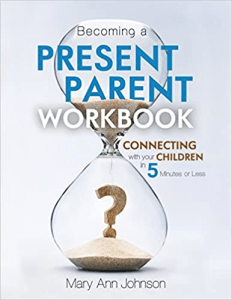 Becoming a Present Parent is well with the $2.99 Kindle ($18.99 soft cover) cost, and for those who like to work things out in a supported and trackable way, there is a companion workbook for $12.99. (I used the workbook, it’s super handy)
Becoming a Present Parent is well with the $2.99 Kindle ($18.99 soft cover) cost, and for those who like to work things out in a supported and trackable way, there is a companion workbook for $12.99. (I used the workbook, it’s super handy)

